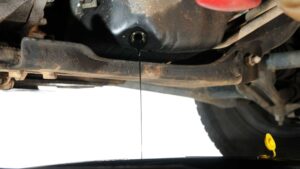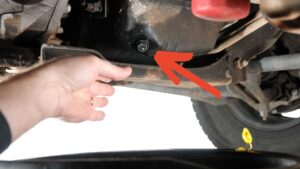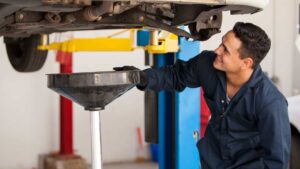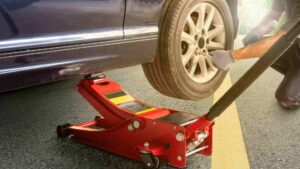If you’re looking for a way to make some extra money, mobile oil changes could be the perfect opportunity. By bringing the convenience of an oil change right to the customer’s doorstep, you can charge a premium for your services while still providing a valuable and affordable service.
Additionally, mobile oil changes are performed in a client’s garage or driveway. This way, you’ll avoid the hassle and expense of renting space in a brick-and-mortar shop. Besides, it can help you save money in the long run.
To get started, you’ll need to invest in a quality mobile oil change kit. This should include all of the necessary equipment and supplies, such as a wrench, oil drain pan, and funnel. You’ll also need to purchase good quality motor oil, as this is an important part of the oil change process. Once you have all of your supplies, you’re ready to start performing mobile oil changes.
Supplies
Tools:

There are only five tools you need to change the oil in a car. You may have some of these tools already if you have your own car. But if not, they’re relatively inexpensive to purchase. You can find them all at your local auto parts store or at the provided links.
- Oil filter wrench: A specialized tool that helps you remove the filter from the car. It’s important to use the proper size wrench to avoid damaging the filter.
- Socket Set: A socket set/torque wrench is used to loosen bolts. You’ll need this to remove the oil drain plug.
- Oil drain pan: This is where you’ll catch the used oil as it drains out of the car. Be sure to get a pan that’s large enough to hold all of the oil from the car. You may want a drain pan that doubles as a container to transport the oil to an oil recycler. Stores like AutoZone will often accept used oil for recycling.
- Funnel: You’ll use the funnel to pour the new oil into the car.
- Oil change ramps (optional): Ramps are not necessary, but they can make it easier to access the underside of the car. If you don’t have ramps, you can use a jack stand (or several alternatives) to prop up the car or drive it up onto a curb.
Consumables:

There are three consumables you need in order to perform a successful oil change. You may have one at home under the kitchen sink, but the other two are specific to each automobile.
- Motor oil: Motor oil is necessary to keep the engine lubricated and running smoothly. Additionally, oil is an integral part of your cars cooling system. Over time, it breaks down and needs to be replaced. Make sure to read the user manual or look up the car online to see what kind of oil is needed. Each car will have its own oil specifications.
- Oil filters: Oil filters help remove impurities from the oil, keeping the engine clean. They also need to be replaced periodically, ideally every oil change. Similar to oil, each car will take a specific filter model, so make sure to look this up ahead of time and order the correct type.
- Rubber gloves: Rubber gloves are not necessary, but they can help keep your hands clean and protect them from getting too cold while you’re working.
Selecting The Right Oil And Filter

One of the most important aspects of performing a mobile oil change is selecting the right oil and filter for the job. The type of motor oil you use will be determined by the make and model of your car, as well as the climate you live in. It’s important to consult your owner’s manual or look up the information online.
You’ll also need to select the right oil filter. Again, consult your owner’s manual or look up the information online for most cars. Online forums are a great resource for older cars if you cannot find an owners manual. The size and type of filter you need will be determined by the make and model of your car.
Now that you have all of the necessary supplies, you’re ready to start performing mobile oil changes.
How To Work On A Car And Make Money: The 7-Steps To Mobile Oil Change Business
Step 1: Finding The Customer
The first step is to find customers. You can do this by advertising your services in local newspapers or online. You can also distribute flyers in neighborhoods where you think most people would be interested in your services.
Pricing for mobile oil changes will vary depending on the make and model of the car, as well as the type of oil used. We recommend checking online or your local auto shop’s rates for reference.
When you’re first starting out your job, it’s a good idea to offer discounts or coupons to attract customers. Once you have a few satisfied customers, word of mouth will start to spread and you’ll get more business.
Step 2: Preparing The Car
Before you start the oil change, you need to prepare the car. Park the four wheels on level ground and set the emergency brake (one of the most important safety features on your car). Put blocks behind the two wheels on the back to prevent the car from rolling.
If you’re using ramps, drive the car up onto them. You must place them under the frame of the car. Be sure to consult the owner’s manual to find out where the jack stand points are.
Step 3: Draining The Oil

Once the car is prepared, it’s time to drain the oil. Locate the oil drain plug under the car. It will likely be on the bottom of the engine.
Place the oil drain pan underneath the plug and remove it with your socket wrench. Be careful, as the hot oil will start to drain out immediately. Let it drain for a few minutes before replacing the plug.

Step 4: Replacing The Oil Filter

While the oil is draining, you can replace the oil filter.
Locate the filter and remove it with a filter wrench. Be sure to consult the owner’s manual or look up the information in online forums to find out where the filter is located.
Once the old filter is off, put the new one on and tighten it. Make sure not to overtighten the filter, as this can damage it.
Step 5: Adding The New Oil

Once the old oil has finished draining, your plug is back in, and the filter is installed, it’s time to add the new oil. Have your funnel ready and pour the new oil into the oil fill hole (what your dipstick goes in).
Again, be sure to consult the owner’s manual or look up the information online to find out how much oil your car takes.
Once the new oil is added, replace the dip stick.
Once the oil has had a second to settle, check the dip stick to ensure that the oil levels are appropriate (between the low and high dot). Make sure you wipe off oil from the dipstick before dipping it to check the oil level.

If there is too much oil, you will need to let some out through the oil drain plug. If there is too little, you will add more oil. Remember, it is always easier to add oil than to go through the mess of draining it.
Step 6: Checking For Leaks

Now that you’ve finished the oil change, it’s time to check for leaks. Look around the oil drain plug and fill-plug to make sure there are no leaks.
If you see any oil leaking, tighten the plugs and check again. If the leak persists, you may need to take the car to a mechanic to have it looked at.
Step 7: Cleaning Up

To finish the oil change, remove the car from the ramps or jack stand and lower it to the ground. Be sure to put all of your tools away and clean up your work area before you go. Be sure to dispose of the used oil and filter properly. Most auto parts stores will take them for recycling.
Congratulations! You’ve Successfully Completed A Mobile Oil Change.

By following the steps above, you can easily start making money with mobile oil changes.
This is a great business to get into if you’re looking for a way to provide convenient and affordable services to customers. Plus, it’s a great way to avoid the hassle and cost of renting space at an auto shop. So, if you like doing maintenance on your own car and are looking for a way to make some extra money, consider mobile oil changes!
FAQs
Do Electric Cars Require Engine Oil Changes?
Electric cars do not require engine oil changes because they do not have traditional combustion engines. Electric vehicles are powered by electric motors, which use electricity stored in a battery to power the vehicle’s wheels. This means that they also don’t need spark plugs or other parts associated with traditional combustion engines to operate.
Is This The Same Process As Changing Your Vehicle’s Steering System Oil
The procedure for changing the oil in a steering system is distinct from that of an engine oil change. While this is a service some people require, it is not a regular service or as simple as an oil change. We recommend only offering this if you are a licensed mechanic.









